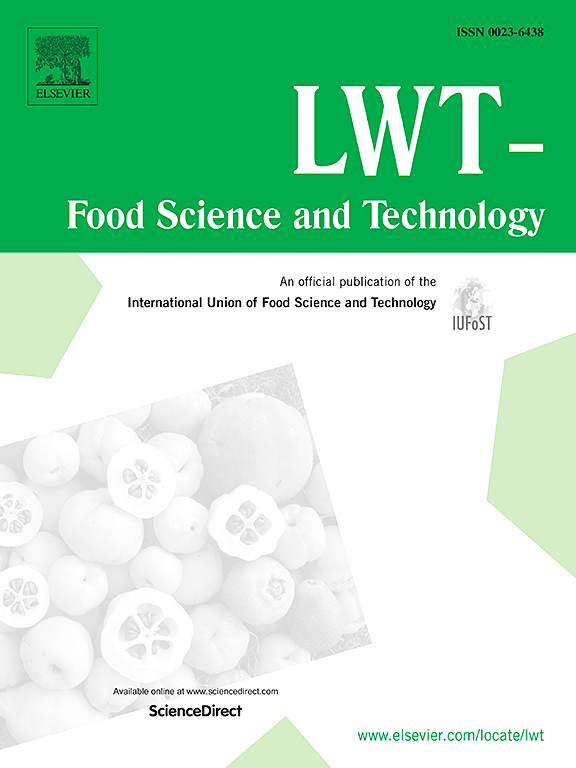香芹酚通过增加生物活性化合物的含量来维持枸杞的抗氧化能力
IF 6
1区 农林科学
Q1 FOOD SCIENCE & TECHNOLOGY
引用次数: 0
摘要
新鲜枸杞容易腐烂和变质,造成经济损失。我们用不同浓度的香芹酚(CVR)(0.06、0.12 和 0.24 μL/mL)熏蒸枸杞,研究了香芹酚(CVR)对枸杞自然病害发生率和质量的影响。结果表明,CVR 处理可抑制枸杞的自然腐烂,提高枸杞的质量、色泽和总可溶性固形物/滴定酸度比。此外,0.12 μL/mL CVR 被确定为最佳浓度,因为它能保持枸杞果实的感官质量(除香气外),并能抑制接种了交替孢霉的枸杞果实的病害发生率和初步病害扩展。经处理的浆果显示出总酚类含量、总黄酮含量、抗坏血酸、谷胱甘肽、褪黑激素、总叶绿素和类胡萝卜素水平的提高。在处理过的浆果中还观察到更高的亲水和亲油总抗氧化活性和自由基清除能力。靶向代谢组学研究表明,用 0.12 μL/mL CVR 处理可提高枸杞中四种酚酸(咖啡酸、绿原酸、阿魏酸和原儿茶酸)和两种类黄酮(柚皮苷和槲皮素)的水平,从而激活苯丙类代谢途径的基因表达。总之,CVR 处理可延缓果实衰老和果实品质下降,促进生物活性化合物的积累,并通过激活苯丙类代谢途径提高抗氧化能力和抗病性。本文章由计算机程序翻译,如有差异,请以英文原文为准。
Carvacrol maintains antioxidant capacity in goji fruit by increasing the content of bioactive compounds
Fresh goji berries are prone to decay and spoilage, resulting in economic losses. We investigated the effects of carvacrol (CVR) on the natural disease incidence and quality of goji berries by fumigating with varying CVR concentrations (0.06, 0.12, and 0.24 μL/mL). The results showed that CVR treatment inhibited the natural decay of goji berries by enhancing their quality, color, and total soluble solids/titratable acidity ratio. Moreover, 0.12 μL/mL CVR was determined to be the optimal concentration, as it maintained the sensory quality (except for aroma) and inhibited the disease incidence and preliminary disease expansion of goji fruit inoculated with Alternaria alternata. The treated berries exhibited elevated total phenolic content, total flavonoid content, ascorbic acid, glutathione, melatonin, total chlorophyll, and carotenoid levels. Higher hydrophilic and lipophilic total antioxidant activities and free radical scavenging capacities were also observed in the treated berries. Targeted metabolomics showed that treatment with 0.12 μL/mL CVR increased the levels of four phenolic acids (caffeic acid, chlorogenic acid, ferulic acid, and protocatechuic acid) and two flavonoids (naringenin and quercetin) in goji berries, thereby activating the gene expression of the phenylpropanoid metabolic pathway. In summary, CVR treatment delayed fruit senescence and the decline in fruit quality, promoted the accumulation of bioactive compounds, and improved antioxidant capacity and disease resistance by activating the phenylpropanoid metabolic pathway.
求助全文
通过发布文献求助,成功后即可免费获取论文全文。
去求助
来源期刊

LWT - Food Science and Technology
工程技术-食品科技
CiteScore
11.80
自引率
6.70%
发文量
1724
审稿时长
65 days
期刊介绍:
LWT - Food Science and Technology is an international journal that publishes innovative papers in the fields of food chemistry, biochemistry, microbiology, technology and nutrition. The work described should be innovative either in the approach or in the methods used. The significance of the results either for the science community or for the food industry must also be specified. Contributions written in English are welcomed in the form of review articles, short reviews, research papers, and research notes. Papers featuring animal trials and cell cultures are outside the scope of the journal and will not be considered for publication.
 求助内容:
求助内容: 应助结果提醒方式:
应助结果提醒方式:


